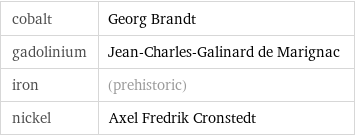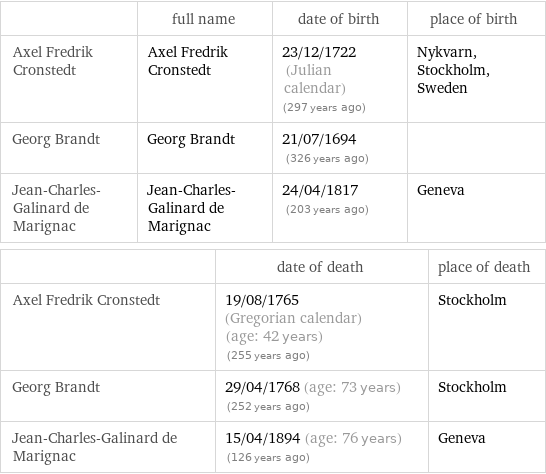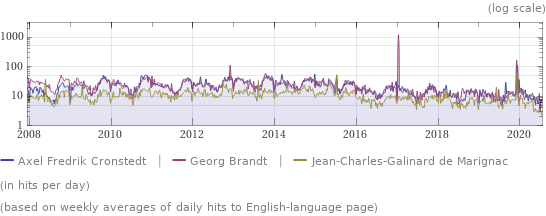Input interpretation

ferromagnetic elements | discoverers
Results

cobalt | Georg Brandt gadolinium | Jean-Charles-Galinard de Marignac iron | (prehistoric) nickel | Axel Fredrik Cronstedt

ferromagnetic elements | discoverers | Axel Fredrik Cronstedt | Georg Brandt | Jean-Charles-Galinard de Marignac (all) (based on 3 values; 1 unavailable)
Basic information

| full name | date of birth | place of birth Axel Fredrik Cronstedt | Axel Fredrik Cronstedt | 23/12/1722 (Julian calendar) (297 years ago) | Nykvarn, Stockholm, Sweden Georg Brandt | Georg Brandt | 21/07/1694 (326 years ago) | Jean-Charles-Galinard de Marignac | Jean-Charles-Galinard de Marignac | 24/04/1817 (203 years ago) | Geneva | date of death | place of death Axel Fredrik Cronstedt | 19/08/1765 (Gregorian calendar) (age: 42 years) (255 years ago) | Stockholm Georg Brandt | 29/04/1768 (age: 73 years) (252 years ago) | Stockholm Jean-Charles-Galinard de Marignac | 15/04/1894 (age: 76 years) (126 years ago) | Geneva
Images

Images
Timeline

Timeline
Wikipedia summary
Axel Fredrik Cronstedt

Baron Axel Fredrik Cronstedt () was a Swedish mineralogist and chemist who discovered the element nickel in 1751 as a mining expert with the Bureau of Mines. Cronstedt is considered a founder of modern mineralogy, for introducing the blowpipe as a tool for mineralogists, and for proposing that the mineral kingdom be organized on the basis of chemical analysis in his book @i@Försök till Mineralogiens eller mineral-Rikets upställing ("An attempt at mineralogy or arrangement of the Mineral Kingdom", 1758).
Georg Brandt

Georg Brandt (26 June 1694 - 29 April 1768) was a Swedish chemist and mineralogist who discovered cobalt (c. 1735). He was the first person to discover a metal unknown in ancient times.
Jean-Charles-Galinard de Marignac

Jean Charles Galissard de Marignac (24 April 1817 - 15 April 1894) was a Swiss chemist whose work with atomic weights suggested the possibility of isotopes and the packing fraction of nuclei. His study of the rare earth elements led to his discovery of ytterbium in 1878 and co-discovery of gadolinium in 1880.
Wikipedia page hits history

Wikipedia page hits history